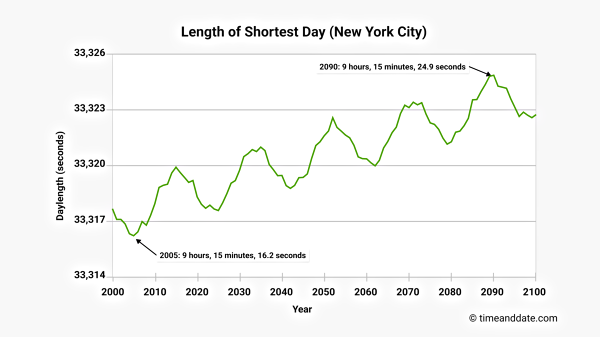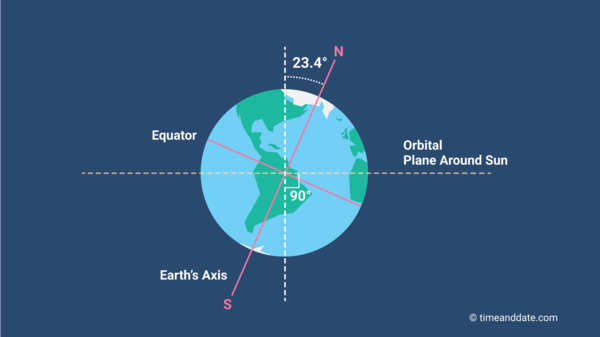The Shortest Day Is Becoming Longer
Many of us would welcome more daylight on the shortest day of the year. So here’s some good news: the year’s shortest day is becoming longer (but only by a few seconds).

Winter starts here: the December solstice produces the shortest day of the year in the Northern Hemisphere.
©iStockphoto.com/Pawel Gaul
The Shortest Day Is Nearly Upon Us
The December solstice—when the North Pole is at its maximum tilt away from the Sun—is the shortest day of the year in the Northern Hemisphere. It can fall on December 20, 21, 22, or 23.
This year it falls on December 21 or 22, depending on your time zone. In New York City, the daylength (the amount of time between sunrise and sunset) will be 9 hours, 15 minutes, and 17 seconds.
Find the daylength for your city
But did you know the length of the shortest day is increasing by a few seconds each century? It is also fluctuating in an 18.6-year pattern linked to the orbit of the Moon.
Not Equally Short Every Year
Using New York as an example, we looked at our data to see how the duration of the shortest day changes over the course of the 21st century. A similar pattern can be seen for other cities in the Northern Hemisphere.


A bumpy, upward trend: how the length of the shortest day of the year varies in New York.
©timeanddate.com
In the chart above, the years are shown from left to right along the horizontal axis, from 2000 to 2100.
The green line indicates the length, in seconds, of the shortest day for each year. We’ve taken the single shortest daylength, from sunrise to sunset, whether it be December 20, 21, 22, or 23.
The shortest December solstice daylength in New York this century was in the year 2005, while the longest will be in 2090. The difference between them is around eight seconds.
We used Federal Hall in Manhattan’s Financial District as the reference point for these measurements.
Planet Earth is an exceptionally accurate timekeeper
A Tale of Two Trends
1. A Long-Term Upward Trend
Our chart highlights two trends. The first is that the overall direction of the line is upward: in general, the shortest day of the year is getting longer by a few seconds each century.
The reason for this is that the Earth’s tilt is slowly decreasing, as part of a repeating cycle that lasts 40,000 years or so.
Today the Earth’s tilt is about 23.4°. But roughly 10,000 years ago it was around 24.2°, while 10,000 years from now it will be about 22.6°.


The Earth is tilted on its spin axis, an imaginary line running from the North Pole to the South Pole. The tilt angle is fairly stable—but it does wobble a little bit.
This small decrease in the tilt of the planet reduces the maximum tilt of the North Pole away from the Sun. This has the effect of making both the shortest and longest days of the year less extreme.
Eventually, the Earth’s tilt will begin increasing once more, and the year’s shortest day will start to become shorter again.
(The Earth’s motions are complex. For example, the orientation of Earth’s roughly 23-degree tilt wobbles, like a gyroscope, in a cycle lasting approximately 25,000 years. At the moment, the North Pole points toward the star Polaris—but this will not be true forever.)
2. Ups and Downs along the Way
The second trend highlighted by the chart is that the line is wavy, not straight. The peaks of the waves come roughly every 18 or 19 years.
The cause of these small oscillations in the length of the shortest day is the Moon.
The Moon’s orbit around Earth is tilted by about 5.1° to Earth’s orbit around the Sun. The orientation of this tilt varies over the course of an 18.6-year cycle, and this causes the Earth’s tilt to vary by about 0.003° over the same period.
Again, this changes the maximum tilt of the North Pole away from the Sun, leading to small differences in the shortest daylength.

In the Southern Hemisphere, the December solstice marks the longest day of the year, and the start of summer.
©iStockphoto.com/Massimo Pollani
Meanwhile in the Southern Hemisphere
In the Southern Hemisphere, the December solstice produces the longest day of the year, as the South Pole reaches its maximum tilt toward the Sun. In the same way as above, the longest daylength is becoming gradually less extreme over the course of this century. In other words: the longest days are getting shorter.
11 things about the December solstice
In Sydney, Australia, the length of the longest day in the year 2000 was 14 hours, 24 minutes, and 47 seconds. In 2100, it will be shorter by about four seconds: 14 hours, 24 minutes, and 43 seconds.